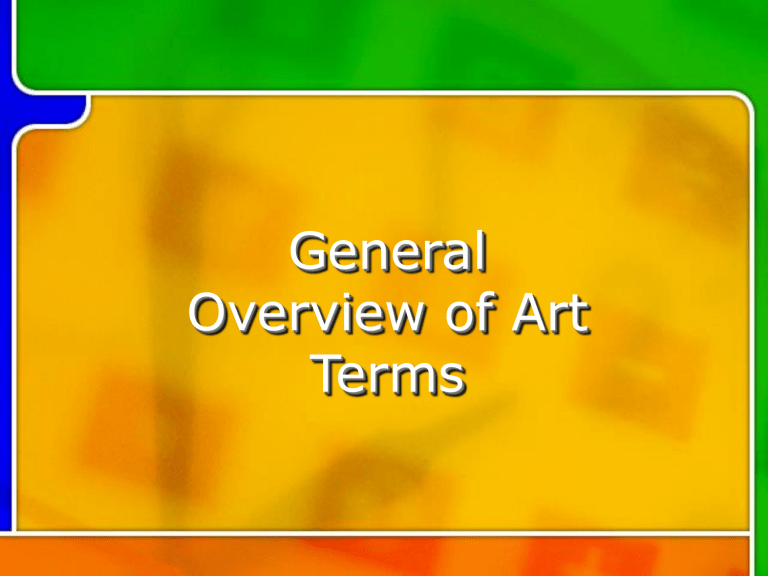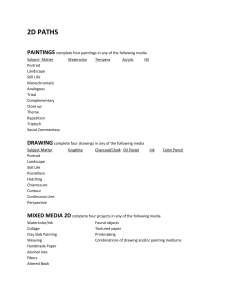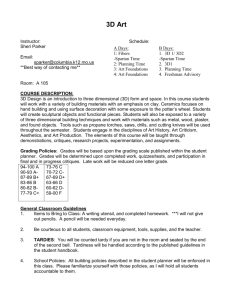place studio ppt

General
Overview of Art
Terms
Printing techniques
Printmaking is a type of artmaking in which multiple originals are created by transferring an image from one surface to a different surface. The different printing methods are: Intaglio; Relief
Lithography; Stencil; and
Monoprint.
Intaglio
The print surface of an intaglio print is incised.
Once the surface has been inked, you rub the ink off the flat part and then use a press to press the paper into the inked grooves.
Engraving
An engraving is a kind of intaglio print where the marks have been made with a tool and actually carved into the surface.
Drypoint
A drypoint is just a specific kind of engraving in which the burrs, or little ridges left as you carve into the metal surface are left on the plate. This creates a soff, fuzzy line.
Drypoint plates wear out more quickly as the metal wears down, meaning you have to make a smaller series.
Burin
A tool used to create an engraving. The artist cuts grooves directly into the surface of a metal plate. Soft, blurred lines are sometimes created when a burr of metal is left on the plate.
Etching
An etching is a type of intaglio print where the incised surface is created with acid. A “ground” is applied to the metal plate and the artist uses different methods to cut through the ground. Where the ground is thinner more acid reaches the plate, leaving a deeper “bite.”
The bottom artwork is a good example of an
“aquatint.”
Relief or Woodcut
In a relief print, the print surface is raised. The artist carves away areas to be left white, and the raised areas accept the ink.
Brayer
A tool used to spread ink on a print plate.
Lithography
A lithograph is created on the concept of grease repelling water.
Special materials are used to create the image on a stone
(litho). Before inking the stone is wet so the ink adheres only to the image area.
Stencil - screenprinting
Stencil, or screen printing is when the image is created by cutting away an area, the ink goes through the part of the screen where the material has been cut away – the other areas remain white. The concept is negative space.
Silk-screen prints and serigraphs are both done this way. Silk-screen prints use a screen made of silk, serigraphs are just the same kind of print but done using a fine mesh screen that isn’t silk.
Monotype
Monotype refers to a printing method where just a single print is created.
Burnish
Rubbing the surface. It can refer to rubbing away the burrs created in the engraving process; rubbing the back of a relief print to transfer the ink from the print to the paper; or rubbing the surface of a clay pot to create a shiny surface.
Cartouche
1. A structure or figure, often in the shape of an oval shield or oblong scroll, used as an architectural or graphic ornament or to bear a design or inscription.
2. An oval or oblong figure in ancient Egyptian hieroglyphics that encloses characters expressing the names or epithets of royal or divine personages.
Enamel
An artmaking technique in which powdered glass is adhered to a surface and melted in a furnace. Many cooking pots are coated with enamel.
Cloisonne’
A method in which very thin ridges of metal are used to separate different colors of enamel.
Conte
A brand of crayon made of graphite and clay, usually in black, red, or brown
Chiaroscuro
1. The technique of using light and shade in pictorial representation.
2. The arrangement of light and dark elements in a pictorial work of art.
Foreshortening
To shorten the lines of (an object) in a drawing or other representation so as to produce an illusion of projection or extension in space.
Frottage
A technique where texture is created by rubbing lead, charcoal or some other material over paper laid on a textured surface. It can also refer to a work of art containing shapes and textures produced by frottage.
Contrapposto
The position of a figure in painting or sculpture in which the hips and legs are turned in a different direction from that of the shoulders and head; the twisting of a figure on its own vertical axis.
Megalith
A very large stone used in various prehistoric architectures or monumental styles.
Cromlech
A circle of standing stones, such as
Stonehenge.
Mihrab
A niche in the wall of a mosque or a room in the mosque that indicates the direction of
Mecca.
Onion dome
A bulb-shaped dome resembling an onion; characteristic of
Russian and
Byzantine church architecture.
Crenellation
The notched top of the wall built around a castle. These regular gaps were originally used for firing arrows.
Columns
Doric Ionic Corinthian
Colonnade
A structure created by, or a series of columns in line and evenly spaced.
Caryatid
A column in the form of a woman.
Frieze
Part of a classical entablature (between the architrave and the cornice) usually decorated with sculpture in low relief, or a decorative band on an outside wall with lettering, decoration, sculpture, etc.
Entablature
The upper part of a Greek or Roman
Order, comprising architrave, frieze, and cornice.
Tracery
Ornamental work in the upper part of a Gothic window.
Campanile
A bell tower, either alone or attached to a building.
Earthworks
Largescale artworks created from the earth itself and designed for a specific location or site.
Embossing
To mold or carve in relief, such as the design on a coin.
Encaustic
A paint consisting of pigment mixed with beeswax and fixed with heat after its application – or the technique of painting with this material.
Fresco
The art or technique of painting on a moist, plaster surface with colors ground up in water or a limewater mixture.
Loom
Hand-operated or power-driven apparatus for weaving fabrics, containing harnesses, lay, reed, shuttles, treadles, etc.
Warp & Weft
Warp fibers run lengthwise in a weaving.
You “dress” or “warp” a loom.
The weft fibers are those woven across, or through the warp.
Genre
A particular class or category of art having a particular form and content. Can also refer to artworks with a subject matter of everyday life.
Gild
Coat with a thin layer of gold leaf.
Golden section
The Golden Section is a Law of
Proportionality. It is a Law that occurs frequently in nature and its use is particularly useful in Art. First developed by Vitruvius, it is most famously known from Leonardo Da
Vinci's 1509 drawing 'The Divine Proportion'
Vanishing point
The point on the horizon where parallel objects seem to intersect
(such as a road).
Gouche
Gouche is an opaque watercolor paint. Unlike transparent watercolor, gouache can be applied in an opaque layer, allowing the artist to use it much like acryilic. It dries to a matte finish, which makes it easily reproducible.
Impasto
The thick application of paint, leading to a rich, textured surface.
Grisaille
A style of monochromatic painting in shades of gray, used especially for the representation of relief sculpture.
Illumination
Decorative representation of a letter in a manuscript.
Maquette
A small model of a sculpture, a preliminary 3D sketch for a larger artwork.
Kore
A sculpture representing a standing young woman clothed in long robes, especially one produced in
Greece before the fifth century B.C.
Kouros
A sculpture representing a standing nude young man, especially one produced in
Greece before the fifth century B.C.
Lost-wax (cire perdue)
A method of creating a mold for a cast sculpture. A wax model is created. The model is immersed in an investment. The model is lost when the mold is created.
Mobile/stabile
A mobile is a piece of abstract sculpture having movable units constructed of sheet metal, wire, or other material and attached to fixed supports – a stabile is the same type of sculpture but it doesn’t move.
Mandorla
•
The Mandorla is an ancient symbol of two circles coming together, overlapping one another to form an almond shape in the middle. Mandorla is the Italian word for almond. The Mandorla is also known as the "Vesica Piscis"
(see the Jensen references below), symbolizing the interactions and interdependence of opposing worlds and forces. Although the symbol has its origins before the
Christian era, the early Christians used the symbol as a method to describe the coming together of heaven and earth, between the divine and human.
Mandala
Any of various ritualistic geometric designs symbolic of the universe, used in Hinduism and Buddhism as an aid to meditation.
Mosaic
A picture or permanent wall decoration made of small, usually colored pieces of inlaid stone or glass.
Odalisque
A representation of a woman who is a female slave or concubine in a harem. Ingres and Matisse are know for painting such figures.
Papyrus
A paper made from thin strips of the pith of a tall, aquatic plant. Used by the ancient
Egyptians,
Greeks and
Romans.
Parchment
Originally the skin of sheep or goats prepared as writing material. A stiff, off-white paper that resembles the original is called parchment.
Vellum
A fine parchment made from calfskin, lambskin, or kidskin and used for the pages and binding of books.
Plein air
Painting out of doors.
Putti
A representation of a cherebic infant, often shown winged.
Sfumato
The subtle and minute gradation of tone and color used to blur or veil the contours of a form in painting.
Tenebrism
From an Italian word, literally meaning dark and gloomy. Frequently the main subjects of tenebrist pictures are illuminated by a single source of light, as if a spotlight shone upon them, leaving other areas in darkness.
Trompe l oeil
To paint in a ultra-realistic manner.
To “fool the eye” into thinking the painting is reality.
Diptych
A pair of paintings or pictures, usually hinged together.
Triptych
A set of three paintings or pictures, usually hinged together.
Polyptych
A work consisting of four or more painted or carved panels that are hinged together.
Pigment
A dry insoluble substance, usually pulverized, which when suspended in a liquid vehicle becomes a paint, ink, etc.
Gesso
Gypsum or plaster of Paris prepared with glue for use as a surface for painting.
Calligraphy
Decorative writing
Caricature
A representation, in which the subject's distinctive features or peculiarities are deliberately exaggerated to produce a comic or grotesque effect.
Cartoon
A “cartoon“ has a contemporary definition and a historic definition. Of course, we’re all familiar with cartoons: Zits, Peanuts, Opus, etc. But historically artists have referred to the full scale drawing of a future fresco or tapestry as a cartoon. The purpose is to create a final composition of the future artwork, so the cartoon is an essential preliminary step in which composition, light, shadow, details of the final artwork is completed.
In a fresco the cartoon is transferred to the plaster surface to provide a reference on the plaster itself.
For a tapestry the cartoon is placed behind the canvas and used as a visual reference as the tapestry is worked from the front.
Camera obscura
A darkened chamber in which the real image of an object is received through a small opening or lens and focused in natural color onto a facing surface rather than recorded on a film or plate.
Codex
A quire of manuscript pages held together by stitching: the earliest form of book, replacing the scrolls and wax tablets of earlier times.
Chalice
A drinking cup or goblet.
Bat & Chuck
• Bat
A plaster disc used for throwing on the wheel.
• Chuck
A shaped object for holding leather-hard pots while they are being turned. They can be made in clay, wood, metal or plaster.
Bat
Leatherhard, Greenware & Bisqueware
• Leatherhard clay is stiff, damp clay that can be turned , trimmed, cut and joined - it is still moist but hard enough to handle without damage
• Greenware refers to clay that is hard but has not been bisque fired
• Clay that has been fired to a sufficient hardness, changing it from dried clay to a hard porous state prior to glaze
Burnishing
Smoothing and polishing a clay or slipped surface with a smooth hard object such as a stone or the back of a spoon, to compact the clay so it forms a hard shell.
Crawling
Retraction of glaze during firing to expose the clay body, caused by a reaction of two or more glazes fired over each other or glazing a pot which is dusty or greasy
Crazing
A fine line pattern appearing on the surface of a glaze caused by tension between a glaze and body (when these have an uneven contraction after firing)
Engobe
A slip mixture with parts of glaze materials incorporated to use on damp pots or on once-fired bisqueware
Grog
Ground fired clay or sand that varies from a coarse grit to a flourlike texture, added to clay to provide openess to the texture and reduce shrinkage. It gives strength to smooth clays and
‘tooth’ (slight resistance) to creamy clay.
Kiln furniture
Refractory shelves and posts upon which ceramic ware is placed while being fired in the kiln
Pug Mill
A mixing machine for clay, a large coil is extruded from which large air bubbles have been extracted
Reduction firing
To fire a kiln with incomplete combustion so that the lack of oxygen creates a smoky atmosphere, thus changing the color of clay, glazes and oxides.
Scraffito decoration
Scratching through a layer of slip, glaze or oxide to the layer below
(can be used in reference to enameling as well)
Types of clay
• Terracotta = clay or an object made in a high iron-content clay that is smooth and fired a rich red brown.
• Stoneware = a hard stone-like ceramic material formed when clay is fired to 2190 degrees F (1200 degrees
C) and over
• Porcelain = a hard, nonabsorbent clay body that is white and translucent, the bisque is low-fired, and the glaze is very high fired (hotter than stoneware)
Drafting tools
• T-square, typically forms a 90 degree angle, made to fit the drawing board
• Triangle, used to draw angles
• Compass, an instrument to form a perfect circle or arc
More drafting stuff…
• Oblique, a three-dimensional drawing where the width of the object will still be drawn as a horizontal line, but the depth can be drawn back at any angle.
• Isometric, another 3D drawing where the width and depth of an object are shown at a 30 degree angle, while the height is shown at a 90 degree angle
• Three view drafting, a set of two-dimensional drawings.
The three views include the front side, top side and one of the sides (typically the right side)
Rapidograph pen
Rapidograph technical pens have been around for a long time now. Even in an age of digital imaging, these thinpointed pens are still standard equipment in many drafting studios.
They are basically fountain pens with an ink reservoir and a small, straight, unyielding tubular point, which can range from about a millimeter at the largest, to superfine hair-thin lines.
How to clean: there is definitely controversy over this question. A former student taking the PLACE said you fill the ink cartridge with water and write with it to clean the point – however, online sources say you soak it in water. Apparently both answers are on the PLACE
– you may want to do further research.
Another disputed question…
There is also a PLACE question that asks what tool to use to get a line of varying thickness. Online sources say NOT to use a
Rapidograph pen. You need a drawing pen with a flat nib, sometimes referred to as an italic.
The pen is turned to different angles, letting the flat side or the thin side of the nib connect with the paper – giving you a varied line width. Different nibs provide different points and line widths.
An oblique is exactly like an italic except that it’s cut on a slant.






